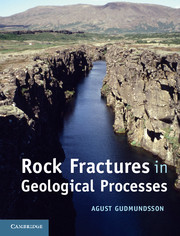Book contents
- Frontmatter
- Contents
- Preface
- Acknowledgements
- 1 Introduction
- 2 Stress
- 3 Displacement and strain
- 4 Relation between stress and strain
- 5 Loading of brittle rocks to failure
- 6 Stress concentration
- 7 Theories of brittle failure of rocks
- 8 Extension fractures and shear fractures
- 9 Displacements and driving stresses of fractures
- 10 Toughness and fracture mechanics
- 11 Field analysis of extension fractures
- 12 Field analysis of faults
- 13 Evolution of extension fractures
- 14 Evolution of faults
- 15 Fluid transport in rocks – the basics
- 16 Fluid transport in faults
- 17 Fluid transport in hydrofractures
- Appendix A Units, dimensions, and prefixes
- Appendix B The Greek alphabet
- Appendix C Some mathematical and physical constants
- Appendix D Elastic constants
- Appendix E Properties of some crustal materials
- Index
- References
1 - Introduction
Published online by Cambridge University Press: 05 June 2012
- Frontmatter
- Contents
- Preface
- Acknowledgements
- 1 Introduction
- 2 Stress
- 3 Displacement and strain
- 4 Relation between stress and strain
- 5 Loading of brittle rocks to failure
- 6 Stress concentration
- 7 Theories of brittle failure of rocks
- 8 Extension fractures and shear fractures
- 9 Displacements and driving stresses of fractures
- 10 Toughness and fracture mechanics
- 11 Field analysis of extension fractures
- 12 Field analysis of faults
- 13 Evolution of extension fractures
- 14 Evolution of faults
- 15 Fluid transport in rocks – the basics
- 16 Fluid transport in faults
- 17 Fluid transport in hydrofractures
- Appendix A Units, dimensions, and prefixes
- Appendix B The Greek alphabet
- Appendix C Some mathematical and physical constants
- Appendix D Elastic constants
- Appendix E Properties of some crustal materials
- Index
- References
Summary
Aims
Rock fractures occur in a variety of geological processes and range in size from plate boundaries at the scale of hundreds of kilometres to microcracks in crystals at the scale of a fraction of a millimetre. This chapter provides a definition of a rock fracture as well as of some of the mechanical concepts used in the analysis of fractures. Some of these definitions are preliminary and more accurate ones will be provided in later chapters. The primary aims of this chapter are to:
Provide a definition of a rock fracture.
Indicate some of the many earth-science topics and processes where fractures play a fundamental role.
Provide definitions of stress, strain, constitutive equations, and material behaviour.
Explain the one-dimensional Hooke's law.
Summarise some basic fracture-related definitions in structural geology.
Discuss the basic information needed to solve fracture problems.
Define and explain boundary conditions, rock properties, and rock-failure criteria.
Explain accuracy, significant figures, and rounding of numbers.
Explain the basic units and prefixes used.
Rock fractures
A rock fracture is a mechanical break or discontinuity that separates a rock body into two or more parts (Fig. 1.1). The continuity or cohesion of the rock body is lost across a fracture. A fracture forms in response to stress. More specifically, the rock breaks and forms a fracture when the applied stress reaches a certain limit, namely the rock strength. The stress associated with the fracture formation may be normal or shear or both.
Information
- Type
- Chapter
- Information
- Rock Fractures in Geological Processes , pp. 1 - 27Publisher: Cambridge University PressPrint publication year: 2011
References
Accessibility standard: Unknown
Why this information is here
This section outlines the accessibility features of this content - including support for screen readers, full keyboard navigation and high-contrast display options. This may not be relevant for you.Accessibility Information
- 2
- Cited by
